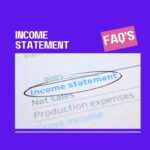What are the main components of a cash flow statement?
The Cash Flow Statement (CFS) consists of three main components:
1. Cash Flow from Operating Activities (CFO)
This section shows cash inflows and outflows from a company’s core business operations. It indicates whether a company can generate enough cash from its normal activities to sustain itself.
Key Components:
- Inflows: Cash received from customers, interest income, dividends received.
- Outflows: Payments to suppliers, employee wages, operating expenses, taxes, and interest paid on loans.
- Calculation Methods:
- Direct Method: Lists all cash receipts and payments.
- Indirect Method: Starts with net income and adjusts for non-cash expenses (e.g., depreciation) and changes in working capital.
2. Cash Flow from Investing Activities (CFI)
This section tracks cash used for or generated from investments in assets and securities. It reflects a company’s long-term growth strategy.
Key Components:
- Inflows: Sale of fixed assets, sale of investments, repayment of loans given.
- Outflows: Purchase of fixed assets (machinery, land, buildings), acquisition of businesses, lending to others.
3. Cash Flow from Financing Activities (CFF)
This section records cash movements related to funding the business through debt, equity, and dividends.
Key Components:
- Inflows: Issuance of shares, borrowing from banks, issuing bonds.
- Outflows: Repayment of loans, dividend payments, share buybacks.
Additional Component:
4. Net Change in Cash & Cash Equivalents – The sum of the above three sections, showing the overall increase or decrease in cash during the period.
How can a company have positive net income but negative cash flow?
A company can have positive net income but negative cash flow due to several factors, primarily related to the differences between accounting profit (accrual basis) and actual cash movement (cash basis). Here are some key reasons:
1. Increase in Accounts Receivable
- Revenue is recognized on the income statement when earned, not when cash is received.
- If a company sells goods/services on credit, net income increases, but cash isn't collected immediately, leading to negative cash flow.
2. High Inventory Purchases
- If a company buys a large amount of inventory, cash is spent immediately, reducing cash flow.
- However, the expense may not yet be reflected in the income statement if the inventory hasn't been sold.
3. Large Capital Expenditures (CapEx)
- Spending on fixed assets (e.g., machinery, buildings) is recorded as an investment (not an expense) in the cash flow statement.
- The cost is depreciated over time on the income statement, so net income remains positive while cash outflows are high.
4. Loan Repayments
- If a company repays debt, the cash outflow is recorded in the financing activities section of the cash flow statement.
- However, loan repayments do not impact net income, which remains positive.
5. Non-Cash Expenses (Depreciation & Amortization Adjustments)
- Net income includes non-cash expenses like depreciation and amortization, which reduce accounting profit but do not affect cash flow.
- If operating cash flow is low despite positive net income, it could indicate weak cash generation.
6. High Accounts Payable or Expense Payments
- If a company pays off its outstanding liabilities (e.g., supplier payments, salaries, rent, or taxes) in bulk, cash outflows rise.
- Even if these expenses were recorded earlier, the large cash outflow reduces cash reserves.
7. Dividend Payments
- A company might pay high dividends despite positive net income, which reduces available cash.
- Dividend payments appear under financing activities but do not impact net income.
What does free cash flow (FCF) indicate about a company's financial health?
✅ 1. Strong Liquidity & Financial Stability
- A positive FCF means the company generates more cash than it spends, making it financially stable.
- It can fund operations without relying on external financing (loans or equity dilution).
❌ 2. Negative FCF – A Warning Sign?
- A negative FCF may indicate that a company is struggling to generate cash or is making heavy investments in future growth.
- However, temporary negative FCF (e.g., due to new facility investments) isn’t always bad, as long as future returns justify it.
📈 3. Growth Potential & Expansion Capability
- High FCF allows a company to invest in R&D, acquisitions, or new facilities without external borrowing.
- Essential for industries like Aerospace & Defense, where large CapEx is common.
💰 4. Ability to Reward Shareholders
- Companies with strong FCF can pay dividends or repurchase shares, increasing investor confidence.
- If FCF is low, the company may struggle to sustain payouts, leading to reduced dividends or stock dilution.
⚠️ 5. Debt Management & Risk Reduction
- High FCF helps in repaying debt, reducing financial risk.
- In capital-intensive industries (like Aerospace, Defense, or CGD), steady FCF is crucial for managing long-term obligations.
🔍 6. Investor & Credit Rating Confidence
- Investors and lenders closely watch FCF as it reflects the company's true earning power.
- A declining FCF trend can be a red flag, while rising FCF attracts investments.
How do changes in cash flow impact a company’s ability to expand or take on new projects?
1. Strong Positive Cash Flow: Supports Expansion & Growth
When a company has consistent positive cash flow, it can:
✅ Invest in new projects – Expansion into new markets, R&D, acquisitions.
✅ Fund capital expenditures (CapEx) – Purchase new machinery, build infrastructure.
✅ Reduce reliance on debt – Self-finance projects rather than take loans.
✅ Attract investors – A strong cash position increases investor confidence.
✅ Support working capital needs – Ensure smooth day-to-day operations.
💡 Example:
A City Gas Distribution (CGD) company with strong cash flow can expand its pipeline network or invest in EV charging infrastructure without relying on heavy borrowing.
2. Negative or Declining Cash Flow: Growth Challenges
When a company faces negative or declining cash flow, it may struggle to:
❌ Fund new projects – Expansion plans may be delayed due to lack of liquidity.
❌ Maintain existing operations – Difficulty in paying suppliers, employees, or debts.
❌ Secure loans easily – Lenders may hesitate to provide financing.
❌ Attract investors – Low cash flow raises concerns about sustainability.
💡 Example:
An Aerospace & Defense company with declining cash flow may struggle to fulfill large defense contracts if it cannot invest in advanced manufacturing facilities.
3. Cash Flow Volatility: Risk Management is Key
Some industries experience seasonal or contract-based cash flow fluctuations, making financial planning crucial.
🔹 Mitigation Strategies:
- Optimize working capital (speed up receivables, delay payables strategically).
- Secure long-term contracts to ensure steady cash inflows.
- Maintain a healthy cash reserve to fund unexpected opportunities or downturns.
💡 Example:
A defense company that wins large government contracts might have high cash outflows initially but large inflows later. Managing this cycle is key to avoiding liquidity issues.
4. Debt vs. Cash Flow: Funding Expansion Decisions
If cash flow is insufficient for expansion, companies may rely on:
💰 Debt Financing – Loans or bonds (higher risk if cash flow is unstable).
📈 Equity Financing – Raising capital from investors (dilution of ownership).
💡 Example:
A CGD company expanding into EV charging stations may issue bonds if current cash flow is insufficient to fund the entire project.
Bottom Line: Cash Flow Drives Growth & Stability
📊 Positive cash flow = Faster expansion, lower risk.
⚠️ Negative cash flow = Growth limitations, financial strain.
How do capital-intensive industries manage cash flow differently from service industries?
📌 Capital-Intensive Industries – Must carefully plan CapEx, secure long-term funding, and optimize contract-based cash inflows to stay financially stable.
📌 Service Industries – Focus more on billing efficiency, reducing receivables, and maintaining recurring revenue models to ensure steady cash flow.
1. Capital-Intensive Industries (Aerospace, Defense, CGD, Manufacturing)
🔹 High CapEx & Fixed Costs – Large upfront investments in infrastructure, machinery, R&D.
🔹 Long Revenue Cycles – Payments come in milestones or long-term contracts.
🔹 Cash Flow Management:
✅ Use debt financing or equity funding for expansion.
✅ Secure advance payments or milestone-based contracts to stabilize cash flow.
✅ Lease expensive equipment instead of buying to conserve cash.
2. Service Industries (IT, Consulting, Banking, Healthcare)
🔹 Low CapEx & Variable Costs – Mostly salaries, office space, and technology.
🔹 Shorter Revenue Cycles – Monthly, subscription, or per-project payments ensure steady cash flow.
🔹 Cash Flow Management:
✅ Focus on faster receivables collection to maintain liquidity.
✅ Use recurring revenue models (e.g., SaaS, retainers) for stable cash inflow.
✅ Avoid heavy debt; rely more on operational cash flow for growth.
How do debt and equity financing impact the cash flow statement?
1. Debt Financing (Loans, Bonds)
📥 Cash Inflows:
✅ Loan/Bond Issuance → Increases cash (Financing Activities)
📤 Cash Outflows:
❌ Loan Repayment → Decreases cash (Financing Activities)
❌ Interest Payments → Decreases cash (Operating Activities)
💡 Key Impact: Quick cash but requires repayments, reducing future cash flow.
2. Equity Financing (Issuing Shares)
📥 Cash Inflows:
✅ Issuing New Shares → Increases cash (Financing Activities)
📤 Cash Outflows:
❌ Dividend Payments → Decreases cash (Financing Activities)
❌ Share Buybacks → Decreases cash (Financing Activities)
💡 Key Impact: Permanent cash inflow with no repayment but may lead to shareholder dilution & dividend costs.
📌 Bottom Line:
- Debt = Short-term cash boost but future repayment burden.
- Equity = No repayment pressure, but dilution & dividend outflows.
What does negative cash flow from investing activities indicate?
📉 Negative cash flow from investing activities means a company is spending more money on investments than it is receiving. This is not always bad—it depends on the reason behind the spending.
Key Reasons for Negative Investing Cash Flow
✅ 1. Growth & Expansion (Positive Indicator)
- High capital expenditures (CapEx) on new plants, machinery, R&D, or infrastructure.
- Acquiring new businesses or expanding into new markets.
- Example: A City Gas Distribution (CGD) company investing in new pipelines or EV charging infrastructure.
⚠️ 2. Asset Liquidation (Neutral or Mixed Indicator)
- Selling assets (real estate, equipment) could offset some expenses.
- If a company sells too many assets, it may struggle to generate future revenue.
❌ 3. Poor Investment Decisions (Negative Indicator)
- Continuous losses from investments (failed acquisitions, declining asset values).
- Example: An Aerospace company investing in outdated technology that fails in the market.
What is the significance of changes in working capital in the cash flow statement?
🔹 Positive Change in Working Capital (Cash Outflow 💸)
❌ Increase in assets (AR, inventory) or decrease in liabilities (AP) → Reduces cash flow.
💡 Example: A CGD company increasing inventory for expansion.
🔹 Negative Change in Working Capital (Cash Inflow 💰)
✅ Decrease in assets (AR, inventory) or increase in liabilities (AP) → Boosts cash flow.
💡 Example: An aerospace firm collecting payments faster than paying suppliers.
📌 Bottom Line:
- Higher working capital = More resources but lower short-term cash flow.
- Lower working capital = Better liquidity but potential financial strain.
Why do companies use the indirect method more often than the direct method?
Companies prefer the Indirect Method for preparing the Cash Flow Statement (CFS) because it is:
1. Easier & Less Costly to Prepare
✅ Uses readily available data from the income statement & balance sheet.
✅ No need to track every cash transaction separately (as required in the Direct Method).
2. Required for Compliance
✅ GAAP & IFRS allow both methods, but the Indirect Method is mandatory for reconciling net income to cash flow.
3. Better for Comparability & Analysis
✅ Commonly used, making it easier to compare companies across industries.
✅ Highlights non-cash adjustments (depreciation, working capital changes), linking net income to actual cash flow.
📌 Bottom Line:
- Indirect Method = Easier, cost-effective, and aligns with accrual accounting.
- Direct Method = More detailed but complex, rarely used.



